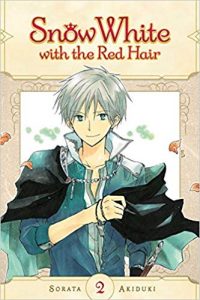Yona of the Dawn Volume 19 by Mizuho Kusanagi
An evaluation of any volume of Yona of the Dawn boils down to the sentiment “if you are not reading this series, there might be something wrong with you.” This particular volume functioned well as bridge between story arcs, as well as including some bonding humor amidst a story of spiritual possession. As the reader can guess from seeing an unmasked Sinha on the cover, the first part of the volume delves more into the history of the Blue Dragon through his encounter with one of his predecessors. There’s plenty of group bonding time along the way as Yona and her companions tease Yun for taking on an inadvertent role as the group’s “mother,” but despite all the teasing he prepares snacks and worries with great maternal instincts.
Sinha’s spiritual possession causes a number of issues, as he returns to the group with another Blue Dragon in control over his body. Everyone but Yun ends up in a super creepy tomb filled with spirits, as they attempt to deal with Sinha’s vengeful spirit. As always, Yona manages to overcome difficulties by simply being true to herself and overcoming obstacles through her humanity and compassion. What initially seems like a story about a vengeful spirit ends up highlighting the strength inherent in forgiveness.
The broader story arc that begins to be set up is a return to the Water Tribe. When Yona and her companions left previously it was clear that they’d affected a small part of a systemic drug trade. While Su-Won strategizes with his generals and tribal leaders in his palace, Yona reunites with Riri and joins up with her again to help with her mission to help the Water Tribe people. As always Kusanagi does an excellent job juggling character development and storylines with such an expansive cast. While Yona is shoujo, the romance elements are fairly sparing, but fortunately there’s a wonderful scene between Yona and Hak as they have trouble sleeping that shows romance progressing slowly. I always put each volume of Yona of the Dawn down feeling immensely satisfied at the amount of story Kusanagi is able to express in just five or six chapters.





Recent Comments